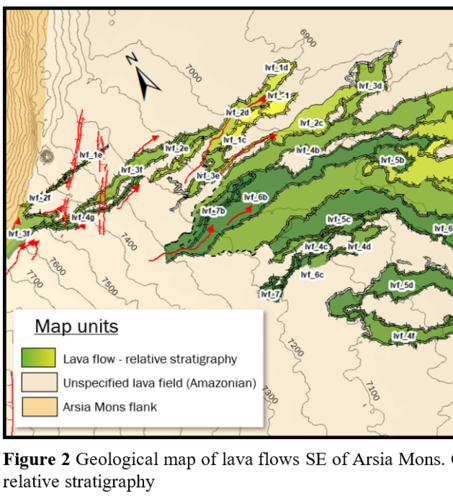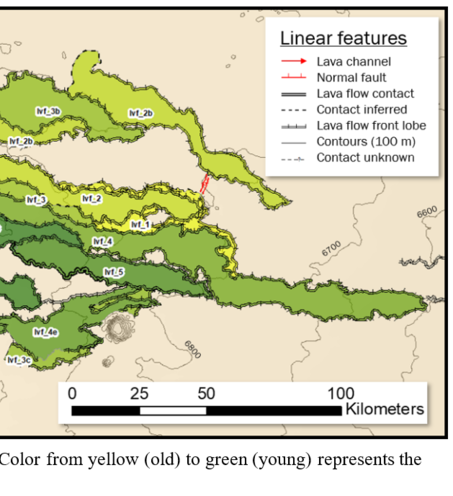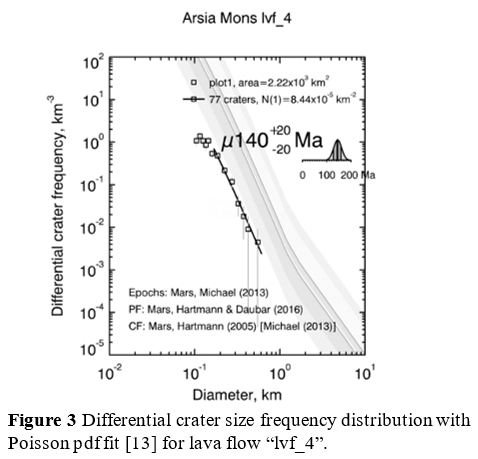Late Amazonian lateral lava flows coeval with caldera eruptions at Arsia Mons
- 1Space Research Centre, Polish Academy of Sciences, ul. Bartycka 18A, 00-716 Warsaw, Poland (pt@cbk.pan.wroc.pl)
- 2Space Science and Technology Centre, Curtin University, Kent Street, Bentley, Perth, Western Australia 6102, Australia
Introduction: The Tharsis dome is the main volcanic province on Mars. Being the locus of volcanism since at least the lower Hesperian, the age of emplacement and succession of its lava flows gives insights onto the thermal evolution of the planet since that time. Late Amazonian volcanic activity has taken the form of a large number of long and narrow lava flows, the vast majority of which unmapped to date. Mapping them is critical to characterize the recent dynamics of the Tharsis volcanism and relationships with tectonic activity. We focus on a group of fresh-looking lava flows located SE of Arsia Mons (Fig. 1). We map individual flows and determine their crater retention age, correlate with stratigraphy.
Geological Setting: Arsia Mons is the southernmost shield volcano of the Tharsis Montes. The edifice is ~400 km wide and rises 10 km above the surrounding topography. Its eruptive history includes explosive and effusive episodes [1]. The youngest episodes are thought to have occurred within the caldera and in the southern rift zone, forming a large fan-shaped lava aprons at 130 Ma [2,3]. Mapping of individual lava flows around vents [4] constrains the intra-caldera activity between 200-300 Ma and 90-100 Ma, with a peak at 150 Ma. The SE lava field (Fig. 1) was previously dated using HRSC data, and inferred to be 189 Ma [3].
Dataset and methods: Individual lava flows are mapped based on CTX images (6 m/px), THEMIS Night and Day-IR imagery (~100 m/px), and MOLA shots, and their succession is established using cross-cutting and stratigraphic relationships.


Absolute ages are estimated using automated crater detection and counting based on machine learning technique [5]. This method was favoured over manual counting because of time efficiency on large surface areas, such as total extents of lava flow. The algorithm was trained on THEMIS images where database for craters >1 km already exists [6]. The algorithm is applied to CTX mosaic from Murray Lab [7] to detect impact craters of diameter >100 m. A second algorithm based on cluster analysis is used to clean clusters of secondary impact craters. Each crater detection is then checked manually by visual inspection. Crater ages and errors are derived from crater size frequency distribution plots using Craterstats II [8] and Hartmann’s chronology system [9].
Results: We have mapped 37 individual lava flows and sorted them with respect to their stratigraphic relationships (Fig. 2). Flow length and width are in the range 20-300 km, and 0.7-21 km. Flows have typically a rugged surface with sometimes a medial channel system, while others display a smoother texture and wider extent.
The flows originate from the southern lava apron of Arsia Mons. The flowing direction is toward ESE, the direction of the current regional slope of the Tharsis dome. In the NW, they overprint SW-NE-trending grabens, but are cut by other normal faults from the same graben system, implying syn-tectonic volcanism. The total number of craters retrieved by the counting algorithm and kept after visual inspection is 948. The age of 23 flows could be obtained. They range from 200±50 Ma to 54±20 Ma, with 80% of lava flows between 60 and 160 Ma. In the SE, the longest lava flows lie on a 470±100 Ma older flow.

Discussion and perspectives: The obtained ages span 150 million years, with an apparent peak age at 150 Ma. This age corelates with the 150 Ma peak eruption age within the caldera [4]. It has been argued that a transition from explosive to effusive style occurred at Arsia Mons 200 Myrs ago [4]. Our results confirm that after effusive volcanism resumed, volcanic activity at Arsia Mons was not restricted to the caldera. Activity centered at the caldera and the southern flank followed a several hundred million years hiatus after main-flank building activity already noted by previous studies [3,4]. Crosscutting relationships between lava flows and bounding faults of concentric grabens indicate that extensional tectonics was coeval with some of the eruptions.
Length compared to width suggests lavas of mafic compositions. Texture pattern visible in CTX shows similarity with flows located further SW and NE of Daedalia Planum and dated 100 Ma [10]. The bright and rugged textures indicate differences in viscosity, similarly to basaltic flows found on the flanks of terrestrial shield volcanoes (aa’ and pahoehoe texture – e.g. [11]).
Morphometric study based on high-resolution digital terrain models will help confirm this interpretation and infer viscosity [12], a first step towards understanding the dynamics of the most recent eruptions at Arsia Mons.
Acknowledgments: This work is supported by the TEAM program of the Foundation for Polish Science (TEAM/2016-3/20), co-financed by the European Union under the European Regional Development Fund. This study is also supported by Europlanet 2024 RI's GMAP project.
References: [1] Ganesh I. et al. (2020) J. Volcanol. Geotherm. Res., 360. [2] Neukum G. et al. (2004) Nature, 432, 971-979. [3] Werner S.C. (2009), Icarus, 201, 44-68. [4] Richardson J.A. et al. (2017), EPSL, 458, 170-178. [5] Benedix, G. K. et al. (2020) Earth and Space Science 7, no. 3 [6] Robbins S. (2012), JGR, 117(E). [7] Dickson J.L. (2018), LPSC, Abstract #2480. [8] Michael G. G. and Neukum G. (2010) EPSL, 294, 223–229. [9] Hartmann W. K. (2005) Icarus, 174, 294–320. [10] Crown, D. A., & Ramsey, M. S. (2017). J. Volcanol. Geotherm. Res., 342, 13-28. [11] Holcomb, R. T. (1987) US Geol. Surv. Prof. Pap, 1350(1), 261-350. [12] Kolzenburg S. et al. (2018), J. Volcanol. Geotherm. Res., 357, 200-212. [13] Michael G. G (2016) Icarus 277:279–285
How to cite: Tesson, P.-A., Mège, D., Lagain, A., and Gurgurewicz, J.: Late Amazonian lateral lava flows coeval with caldera eruptions at Arsia Mons, Europlanet Science Congress 2020, online, 21 September–9 Oct 2020, EPSC2020-710, https://doi.org/10.5194/epsc2020-710, 2020

